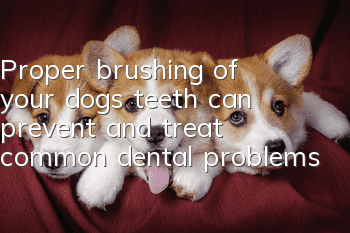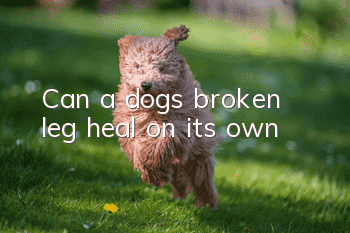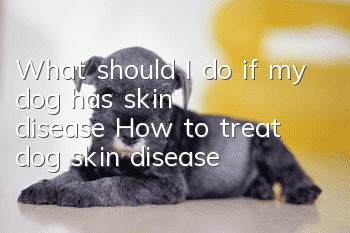Proper brushing of your dog’s teeth can prevent and treat common dental problems

Dog teeth will gradually turn yellow and become more and more worn with age. This is a normal physiological process. However, good tooth brushing (teeth cleaning) habits can effectively protect the dog's teeth, but many owners ignore this.
According to a 2015 questionnaire survey of 919 owners by the Japan Pet Research Institute, only 15.3% of owners brush their dogs’ teeth with a toothbrush every day, 26.2% brush once or twice a week, and 7.6% brush once or twice a month. 2 times; on the other hand, up to 50% of owners have not developed the habit of brushing their dogs’ teeth.
If you don't pay attention to brushing your dog's teeth at ordinary times, it will easily cause more bacteria and dirt to accumulate in his mouth, and dental plaque will accumulate. If the situation is serious, his teeth will slowly turn yellow and form dental calculus. In addition, there may be Induces oral diseases such as gingivitis and periodontitis. Severe infections can spread and cause life-threatening illness.
It is necessary to brush the dog's teeth when he is 6 months old. If the dog's oral condition is good, he can brush his teeth 2-3 times a week. It is best to brush his teeth every day. The dog will definitely not adapt to it or even resist it at first, but if it can be adapted to brushing, it will be great for the dog’s teeth.
Symptoms of oral disease:
Cats and dogs have bad breath and brown or yellow tartar near their gums. When chewing food, the gums will bleed, the gums will swell, there will be pain, loose teeth, abnormal increase in saliva, loss of appetite and listlessness.
Common dental problems in dogs:
Dental calculus
Dental calculus is mainly composed of food residues and bacteria, which can cause bad breath and even periodontal disease. Once dental calculus forms on a dog's teeth, it is difficult to remove.
Once dental calculus (brown tartar at the junction of teeth and tooth roots) forms, it will be very laborious to clean. But if left unchecked, dogs will begin to lose teeth at a young age, and dental care should begin at an early age.
Gingivitis
Gingivitis is the precursor of periodontal disease. The place where the gums and teeth meet is called the "gingival sulcus". Since dogs don’t know how to clean their teeth, after countless meals, a lot of food residue accumulates in their gums, causing bacteria to grow in large numbers. After bacteria invade the gums, they will inflame the gums and cause pain.
Periodontal disease
If the owner does not take care of the dog's teeth on a daily basis, calculus will grow on the dog's teeth over time. If the situation does not improve, the accumulation of dental calculus will turn into periodontal disease. Periodontal disease will cause the gum tissue to become abscessed, inflamed and bleed, severely destroying the gum tissue, causing significant tooth vibration, and eventually leading to massive tooth loss.
Tooth decay
Except for peopleIn addition, dogs can also suffer from tooth decay. The cause of tooth decay is the accumulation of food residues in the mouth, and then bacteria use the food residues as nutrients to continue to breed. While multiplying, they will also produce an acidic substance. When this acidic substance comes into contact with the teeth, it will Tooth decay is caused by slowly dissolving calcium in teeth and forming cavities. Tooth decay can cause pain in the dog's gums, tooth necrosis, and a significant loss of appetite.
So how to brush your dog’s teeth:
You can try this first: see if your dog is willing to have you rub your fingers along its upper gums and teeth. This will help it get used to the feeling of brushing. Put some dog toothpaste on your fingertips and let your dog lick the toothpaste from your fingertips so he can get used to it. If after a few days he refuses to lick more toothpaste, try a different flavor.
In the first two weeks, you can give your dog an adaptation process, and then brush its teeth with a canine toothbrush. The specific operations are:
Then take a gauze strip dipped in a little saline solution and wrap it around your index finger, and wipe the gums and between the teeth in sequence. Be gentle to avoid damaging the gums. After the dog adapts, dip a little pet toothpaste in it and brush its teeth. This toothpaste does not require Rinse your mouth and let it dry on its own.
Be careful not to stand in front of your dog or take a threatening stance. Instead, try kneeling or sitting in front or to the side of it. Gauge your dog's anxiety level. If it seems resistant, stop and try again later. In the first few times, the dog will run away because it is not used to it, and the owner must patiently help it adapt.
Preparation of toothbrushing tools:
You can use a toothbrush specially made for dogs, with softer and more angled bristles. In addition, a finger brush is suitable for dogs under 30 pounds. For larger dogs, a longer handle provides better reach. Be sure to use dog toothpaste that comes in dog-friendly flavors, such as poultry or peanut butter. Follow the directions on the pet toothpaste label and brush your teeth with an appropriate amount of toothpaste, covering the surface of each tooth.
Never use human toothpaste, which contains ingredients that may harm your dog's stomach.
Officially start brushing your teeth:
When your dog gets used to having his mouth opened and touched, start using toothpaste and a toothbrush together. Lift his upper lip and as you approach the brush toward his teeth, angle the bristles so the toothbrush reaches the gum line. Holding the toothbrush against its teeth at a 45-degree angle will help the bristles massage the gum line and remove plaque.
Slight bleeding may occur as you move the bristles along the gum line. Light bleeding every once in a while is relatively normal, but constant or heavy bleeding may mean you're brushing too aggressively, or it'sThis may be a sign of gum disease and contact your veterinarian for advice.
Pay special attention to dental plaque:
Brushing teeth should be done step by step. Brush a few teeth at a time and slowly let the dog adapt. If your dog resists initially, use a circular brushing motion, trying to start on the outside of the canines and back teeth, where plaque tends to collect.
If you have access to the inside, that's great. But don’t worry if you can’t access the inside of your teeth; your dog’s rough tongue can also help keep the area clean.
To soothe the dog:
Talk to it while you brush your teeth and tell it what you are doing. Soothe him by stroking his chin or patting his head to let him know that this is not a harmful thing.
When you're done brushing your dog's teeth, reward him with his favorite treat or extra companionship to let him know what a great job you've done.
Also remember that good dental care doesn’t end with brushing. Chewable snacks and a good diet such as raw meat and bones can also help you fight plaque buildup. Regularly feed your dog fresh vegetables and fruits rich in vitamins and fiber. You can also give it various bone chews such as vegetable sticks, which can exercise your dog's teeth. The biting force can also play a role in cleaning tartar and tartar.
Of course, you should avoid giving your dog too many sweets to avoid tooth decay. Regularly supplementing your dog with some B vitamins can reduce oral morbidity, and don’t forget to schedule regular professional dental cleanings.
Under what circumstances can a dog not brush its teeth?
When a dog has severe periodontitis, it needs a period of oral treatment before brushing its teeth. And if you have just had your teeth cleaned at the animal hospital for the first 3 days, your gums have not been repaired and it is not suitable to brush your teeth.
Finally, if your dog refuses to brush his teeth, how can you protect his teeth?
Breath fresheners and chewable tablets: can improve the dog's oral odor and reduce the adhesion of dental plaque. You can also use mouthwash specially designed for pets (spray it directly on your teeth or mix it into drinking water).
Diet/Pet Food: Dry food is best for cats and dogs’ teeth, because dry food has a frictional effect and helps remove plaque on the crowns of teeth, and dry food is not as easy to fill into the gum gaps as wet and soft food.
Gum exercise: Let the dog chew on toys, biscuits, artificial bones, knotted ropes, etc., to provide exercise and friction opportunities for the dog’s gums, which helps to remove plaque on the crowns.
- Signs of disease in dogs
- What causes dogs to poop black?
- Dog Teeth and Oral Care
- Can a pregnant dog be bathed?
- Four Reasons Why Dog Training Fails
- How to feed a two-month-old puppy
- What should I do if my Neapolitan Mastiff eats too much and has diarrhea?
- What geriatric diseases do dogs have? What are the characteristics of dog aging?
- What should I do if my dog has a fever? How to treat?
- How does a novice train a Samoyed to use the toilet? Training the Samoyed to use the toilet!



